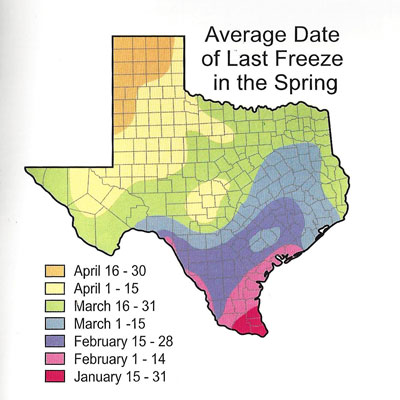Question of the Week: February 20, 2020

“Neil, how will I know when it’s safe to plant my frost-sensitive flowers and vegetables?”
You will know when it’s safe to plant cold-sensitive annual flowers and vegetables about a month after the last killing freeze. Yeah, I did mean to say “after.” Texas is crazy, and late freezes seem to come out of nowhere.

So my first answer isn’t practical. Let’s go for the more useful one. Let’s use the law of averages. This is the “last-freeze” map from Page 3 of my newest book, Neil Sperry’s Lone Star Gardening (see ordering information here). It shows the average date of the last killing freeze for the entire state. Mind you, this is only a batch of averages, and it comes with absolutely no guarantees.
However, as a rough rule of thumb, you still have probably an 80 percent chance of at least one more killing freeze if you plant more than a couple of weeks before the average date for your area. By the time you’re two weeks past the average date for your area, odds of a damaging frost are down to probably 10 or 20 percent.
In simpler terms, don’t push your luck by planting too early (soils will be too cold), but don’t delay too long (summer will catch up with your crops).
Did you know…
…that killing frost can form at temperatures several degrees above 32F? It can, and it does. It will only happen on clear and still nights, so if you hear that it’s going to be windy or cloudy all night, you won’t have a killing frost. However, if it’s completely calm and sparklingly clear, frost will probably form. It will start in the low pockets of still air – which is why orchard managers plant their fruit trees on hillsides.
